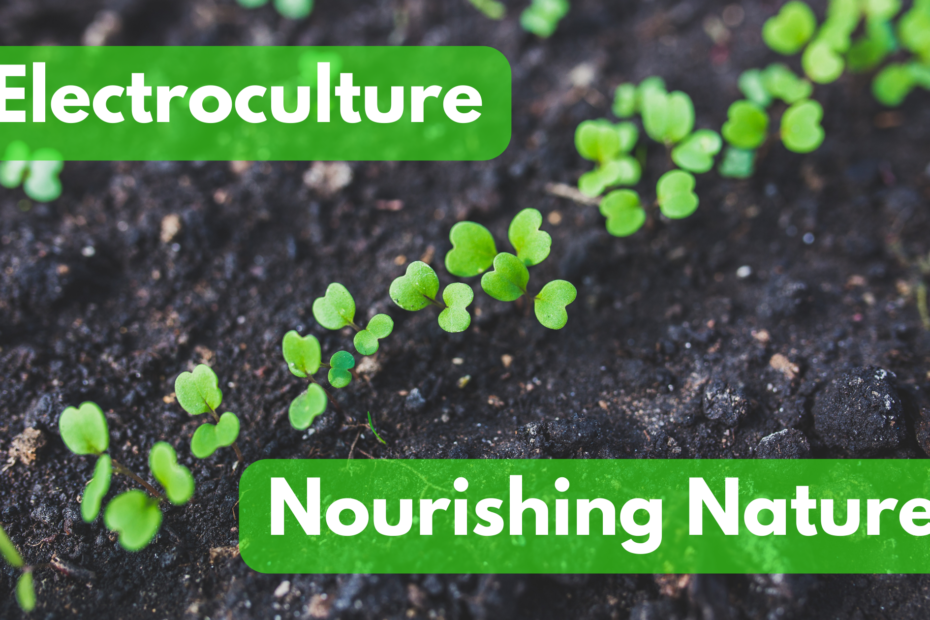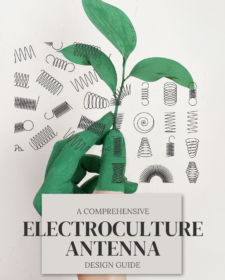Electroculture gardening is an innovative agricultural technique that utilizes electrical currents to stimulate plant growth and enhance soil nutrient availability. This methodology harnesses electrical energy to create favorable conditions for plant development, thereby potentially increasing crop yield and health.
Historical Context
The concept of electroculture dates back to the early 20th century, with initial experiments conducted by scientists like Justin Christofleau. These early investigations laid the groundwork for modern practices, though interest waned during the mid-20th century due to the rise of chemical fertilizers and pesticides.
Mechanisms of Action
Electroculture involves several key mechanisms:
- Electro-stimulation of plant cells: Electrical currents can promote cellular activities, such as ion transport and enzyme activation, which are vital for plant growth and development.
- Enhanced Soil Micronutrient Availability: Electrical fields can facilitate the release of essential micronutrients from soil particles, making them more accessible to plant roots.
- Soil pH Adjustment: Electroculture can influence the soil’s pH levels, optimizing conditions for nutrient uptake.
Equipment and Materials
To implement electroculture gardening, specific equipment and materials are essential:
- Electrodes: Copper or graphite rods inserted into the soil.
- Power Source: Batteries or solar panels to generate low-voltage currents.
- Voltage Regulators: Devices to control the current flow and prevent damage to plants.
- Insulating Materials: Non-conductive materials to channel electrical energy effectively.
Benefits
Electroculture gardening offers a range of benefits:
- Increased Growth Rates: Enhanced cellular activities result in faster growth rates for many plant species.
- Improved Nutritional Quality: Electrostimulation can enhance the nutritional profile of crops, contributing to higher levels of vitamins and minerals.
- Sustainable Practice: Reduces reliance on chemical fertilizers and pesticides, contributing to eco-friendly agricultural practices.
Current Research
Recent studies have focused on optimizing electroculture techniques for various crops. Research is ongoing to determine:
- Ideal Electrical Parameters: Identifying the optimal voltage and frequency for different plant species.
- Long-term Effects: Understanding the sustainable impact on soil health and crop productivity over extended periods.
- Economic Viability: Assessing the cost-effectiveness compared to traditional agricultural methods.
Electroculture gardening embodies a blend of historical ingenuity and modern technological advancement, offering promising avenues for sustainable agriculture.
Historical Background and Development of Electroculture
Electroculture, as a concept, traces its origins back to the early 18th century, with experimental observations by scientists such as Volta and Faraday, key figures in electricity and magnetism. The term itself was coined in the late 19th century when various researchers began to explore the effects of electric currents on plant growth. Noteworthy early proponents included Sir Jagadis Chunder Bose, who conducted experiments demonstrating the effects of electrical stimuli on plants.
In the 1920s and 1930s, the practice gained more structured scientific inquiry. Researchers like Viktor Schauberger noted the potential of harnessing natural energies to boost agricultural productivity. The experiments conducted during this period laid the groundwork for understanding how electrical currents, magnetism, and other electromagnetic influences affect plant metabolism and growth.
Studies conducted by contemporary researchers such as Justin Christofleau further validated these early findings. Christofleau focused on the practical application of electroculture methods to improve crop yields and overall plant health. His work, largely overlooked by mainstream agriculture at the time, demonstrated significant improvements in plant vitality and resistance to diseases through the application of electrical fields.
Advancements in the 20th century incorporated more sophisticated technology. Electrophysiology, a branch of biology, began studying the electrical properties of biological cells and tissues more rigorously. This period also saw the emergence of devices designed specifically for electroculture, such as the oscillating electric field generators and magnetic field generators. These tools contributed to more refined methods of applying controlled electrical stimuli to plants.
More recently, research has shifted towards understanding the molecular and genetic responses of plants to electrical stimuli. Modern studies often focus on the biomagnetic and bioelectric aspects of plant physiology, exploring how these influence essential functions such as nutrient absorption, photosynthesis, and resistance to environmental stressors. The use of nanotechnology and biophotonics has opened new avenues for precise and targeted applications of electromagnetism in horticulture.
Though mainstream agriculture has been slow to adopt electroculture, recent interests in sustainable and alternative farming practices have rekindled scientific and practical explorations into its potential benefits. Researchers continue to investigate optimal techniques and technologies to integrate electroculture into contemporary agricultural systems, aiming to enhance productivity while reducing reliance on chemical fertilizers and pesticides. The historical landscape of electroculture reflects a trajectory of curiosity and innovation, continually evolving with scientific advancements.
Fundamental Principles and Mechanisms of Electroculture
Electroculture gardening is based on the principle of applying electrical currents or fields to plants and soil to enhance growth and yield. The mechanisms at work involve several scientific principles that contribute to the observed benefits in plant development.
Ionization and Soil Enhancement
- Ionization: Electrical currents help ionize soil nutrients, making them more accessible to plant roots. This process enhances nutrient uptake by plants.
- Soil pH Regulation: Electroculture can influence soil pH levels, promoting an optimal acidic or alkaline environment conducive to plant growth.
- Microbial Activity: The introduction of electrical fields stimulates microbial activity in the soil, enriching the soil with beneficial microorganisms.
Electrokinetics
- Electrophoresis: Soil particles and water molecules are mobilized through electrophoresis, facilitating better water infiltration and distribution.
- Electro-osmosis: This mechanism assists in moving soil-water solutions towards plant roots, improving hydration efficacy.
Plant Physiological Responses
- Enhanced Photosynthesis: Plants exposed to electromagnetic fields show increased photosynthetic activity, leading to higher energy production and growth rates.
- Improved Cellular Respiration: Electrical stimulation boosts cellular respiration, ensuring that plants utilize nutrients more effectively.
- Hormonal Balance: Electroculture helps in regulating the hormonal balance within plants, particularly auxins and gibberellins, which are critical for growth and development.
Field Application Techniques
- Electrodes in Soil: Placing electrodes in the soil allows for targeted electrical currents to stimulate root zones directly.
- Aerial Antennae: Using aerial antennas to capture atmospheric electrical charges can create a beneficial electric field around plants without direct contact.
- Magnetic Field Enhancement: Integrating magnetic fields can complement electrical stimulation, further optimizing plant growth conditions.
Implementation Challenges
- Electrical Safety: Ensuring that the electrical setups in gardens are safe for both plants and humans is paramount.
- Energy Consumption: Monitoring and managing energy consumption to avoid excessive use is critical.
- Environmental Variability: Adapting electroculture techniques to different environmental conditions requires careful calibration and experimentation.
By harnessing these fundamental principles and mechanisms, electroculture offers a unique approach to improving plant health and productivity in gardening and agricultural practices.
Scientific Basis and Experimental Evidence Supporting Electroculture
Electroculture gardening, as a technique for enhancing plant growth, derives its theoretical foundation from principles in electromagnetism and biology. Researchers have investigated how electromagnetic fields (EMFs) influence biological systems, particularly in relation to cellular processes and nutrient uptake in plants. Electroculture encompasses several methods, including the use of static electricity, electric fields, and electromagnetic fields to stimulate plant growth.
Electromagnetic Fields and Plant Growth
- Cell Metabolism Enhancement: EMFs have been observed to accelerate cellular metabolism in plants. Studies reveal that EMFs can enhance the synthesis of adenosine triphosphate (ATP), a crucial molecule for energy transfer within cells.
- Improved Nutrient Uptake: Exposure to electric fields can increase the movement of ions across cell membranes, thereby promoting nutrient absorption and transport. This effect can lead to more robust growth and improved health of plants.
- Increased Photosynthetic Efficiency: Research demonstrates that EMFs can influence the photosynthetic apparatus, potentially increasing the rate of photosynthesis. Enhanced photosynthesis translates directly to higher biomass production.
Experimental Evidence
- Controlled Laboratory Studies: Numerous greenhouse experiments have indicated significant improvements in plant growth metrics, such as germination rates, leaf area, and biomass, when subjected to optimized electric field conditions.
- Field Trials: Open-field trials have also yielded promising results. For instance, crops exposed to EMFs showed increased yields and resistance to adverse environmental conditions, suggesting practical applications for agricultural productivity.
- Historical Trials: Early 20th-century experiments by pioneers like Georges Lakhovsky have contributed foundational evidence supporting the effectiveness of electroculture. His oscillating circuits and antenna systems demonstrated favorable outcomes on crop vitality and growth rates.
Mechanisms at Play
Researchers propose multiple mechanisms through which electroculture operates:
- Activation of Ion Channels: Electromagnetic stimulation may open or modify ion channels in plant cells, facilitating the flow of essential nutrients and minerals.
- Induction of Hormonal Changes: EMFs can potentially influence the levels of growth-regulating hormones such as auxins and gibberellins, critical for plant development and maturity.
- Stimulation of Antioxidant Production: Plants exposed to EMFs may exhibit increased antioxidant activity, aiding in stress resistance and overall vitality.
The convergence of electromagnetism and plant biology in electroculture provides a compelling avenue for optimizing horticultural practices, with a growing body of scientific evidence substantiating its efficacy.

Types of Electroculture Techniques and Their Applications
Electroculture gardening encompasses various techniques, each presenting distinct applications and benefits:
Magnetite Method
The magnetite method utilizes magnetic fields to influence plant growth. Researchers place magnets in the soil or around planting areas to produce these fields. This approach has been applied to enhance nutrient absorption, increase seed germination rates, and bolster overall plant health. By aligning with the Earth’s natural magnetic field, plants can sustain accelerated growth and improved resistance to diseases.
Atmospheric Electricity
Atmospheric electricity techniques involve capturing electrical energy from the atmosphere. Gardeners typically employ antennas and grounding rods to harness this energy. The primary application lies in providing continuous low-level electrical stimulation to the plants, which can enhance growth rates and improve nutrient uptake. Field studies suggest that crops subjected to atmospheric electricity show increased yields and greater resilience against environmental stressors.
Capacitor Charging
In the capacitor charging approach, capacitors store electric charges and release them into the soil at specific intervals. This intermittent energy release can foster better root development and stimulate plant growth cycles. By fine-tuning the discharge rates, gardeners can optimize growth conditions for different plant species, making this technique versatile across various horticultural applications.
Electrostatic Culture
Electrostatic culture entails employing static electricity to influence plant growth. Devices generating electrostatic fields are situated near the plants. This method has proved beneficial in reducing pest populations and enhancing crop yields. Electrostatic fields can also modify the polarity of plant cells, potentially leading to increased photosynthetic efficiency and greater biomass production.
Soil Ionization
Soil ionization involves inserting electrodes into the ground to induce ionization of soil particles. This process enhances nutrient availability and promotes microbial activity in the soil. Soil ionization has been beneficial in organic farming, where it supports the natural balance of the soil ecosystem without chemical inputs. Results show that ionization can lead to robust plant growth, higher fruit quality, and improved soil health.
Each method within electroculture gardening offers unique advantages and can be tailored to specific agricultural needs, making electroculture a promising avenue for modern horticulture advancements.
The Role of Electric Currents in Plant Growth and Development
Electric currents play a pivotal role in the physiological processes and overall health of plants. Research has shown that weak electrical stimulation can enhance nutrient uptake, promote growth, and improve plant vigor. Electroculture techniques leverage these bioelectric responses to optimize plant growth.
Mechanisms at Work
- Cellular Excitation: Electrical currents influence cell membrane permeability, facilitating the movement of ions and nutrients into plant cells. This enhanced permeability can lead to increased metabolic activity and faster growth rates.
- Hormonal Changes: Electrical stimulation can alter the production and distribution of phytohormones such as auxins, cytokinins, and gibberellins. These hormones regulate various aspects of plant development, including cell division, elongation, and differentiation.
- Enhanced Photosynthesis: There is evidence to suggest that electric fields can enhance the photosynthetic efficiency of plants. Increased chlorophyll production and more efficient conversion of light energy into chemical energy are potential outcomes.
- Root Growth and Development: The root system is critical for the uptake of water and nutrients. Electrical stimulation has been found to accelerate root growth and improve root structure, making plants more resilient and better able to access soil resources.
Practical Applications
Employing electroculture methods in gardening involves several practical steps:
- Electrodes and Wiring: Electrodes are placed in proximity to plant roots. These can be made from materials such as copper or zinc, which are known to conduct electricity well.
- Voltage Regulation: A controlled and consistent voltage is essential. Overstimulation can be detrimental, while under-stimulation may have negligible effects. The optimal range often falls between 1 to 5 volts.
- Timing and Duration: Electric currents can be applied at different stages of plant growth. Initial stages of seed germination and early growth phases are particularly responsive to electrical treatment.
- Environmental Conditions: Factors such as soil type, moisture content, and ambient temperature can influence the effectiveness of electric currents.
Electroculture harnesses the potential of electric currents to foster a thriving garden. Understanding these underlying mechanisms offers a scientific basis for its application in sustainable agriculture and home gardening.
Comparative Analysis: Electroculture vs. Traditional Gardening Methods
Electroculture gardening introduces innovative techniques that differentiate itself from traditional gardening methods. A comprehensive comparison illuminates the merits and drawbacks of both approaches.
Soil Fertility and Nutrient Absorption
Traditional Methods:
- Fertilization: Utilizes organic or synthetic fertilizers to enrich soil.
- Soil Management: Involves practices such as crop rotation and tilling to maintain soil health.
- pH Balancing: Regularly adjusted by adding lime or sulfur compounds.
Electroculture:
- Increased Nutrient Uptake: Electromagnetic fields enhance the bioavailability of nutrients.
- Reduced Dependency on Fertilizers: Minimal use of external nutrient inputs due to improved efficiency in nutrient absorption.
- Soil Aeration: Electromagnetic stimulation promotes better soil aeration, reducing compaction.
Water Usage and Conservation
Traditional Methods:
- Irrigation Systems: Rely on conventional sprinkler or drip irrigation systems.
- Water Retention: Utilizes mulching and soil amendments to retain moisture.
- Evaporation Control: Implements methods like shading or using cover crops to reduce water loss.
Electroculture:
- Enhanced Soil Hydration: Electromagnetic influences improve soil structure, enhancing water retention.
- Efficient Water Use: Lower water consumption due to optimal hydration of plants.
- Drought Resistance: Plants exhibit increased drought resistance and resilience under electrocultural care.
Growth Rates and Crop Yields
Traditional Methods:
- Growth Stimulators: Use of growth hormones and organic stimulants.
- Pest Management: Relies on chemical or natural pest control methods to protect crop yields.
- Harvest Cycles: Governed by seasonal variations and traditional growth cycles.
Electroculture:
- Accelerated Growth: Magnetically charged environments stimulate faster plant growth.
- Enhanced Yield: Higher crop yields owing to improved plant metabolism and nutrient uptake.
- Pest Resistance: Plants display natural resistance to pests and diseases under electrocultural practices.
Environmental Impact
Traditional Methods:
- Chemical Residues: Potential for residue build-up from synthetic fertilizers and pesticides.
- Carbon Footprint: Emissions related to the production and transport of agricultural inputs.
- Soil Erosion: Tilling and cultivation practices may lead to soil erosion over time.
Electroculture:
- Reduced Chemical Use: Minimal use of chemicals leads to fewer residues.
- Lower Carbon Emissions: Reduced dependency on transported agricultural inputs.
- Soil Preservation: Improved soil structure mitigates erosion risks.
Electroculture gardening emerges as a progressive alternative, leveraging electromagnetic inputs to foster sustainable and efficient farming practices. This comparative analysis underscores the transformative potential of electroculture in revolutionizing contemporary gardening methodologies.
Practical Applications
Electroculture involves employing electrical fields to enhance plant growth, improve soil fertility, and increase crop yields. In modern agriculture, this innovative practice has widespread applications.
Enhancement of Plant Growth
- Seed Germination: Applying electric fields during the germination phase can expedite the process. Research demonstrates that seeds exposed to electrical stimulation exhibit a higher and faster germination rate.
- Stimulation of Root Development: Electrical currents can be used to stimulate root growth, enhancing nutrient and water absorption. This is particularly beneficial in hydroponic systems where efficient root development is crucial.
Soil Fertility Improvement
- Electrolytic Soil Treatment: Providing low-voltage currents to soil can improve its structure and fertility. This method aids in breaking down organic matter more efficiently, allowing nutrients to be more readily available to plants.
- Reduction of Soil Salinity: Electroculture can mitigate soil salinity by aiding in the movement and leaching of salts away from the root zone, thus improving conditions for plant growth.
Increase in Crop Yields
- Disease Resistance: Plants exposed to electric fields often show increased resistance to diseases. This resistance can result from enhanced physiological changes in the plant, such as improved metabolic rates and stronger cell structures.
- Enhanced Photosynthesis: Electric stimulation can boost the photosynthetic process, leading to faster growth rates and higher biomass production. This results in overall higher yields.
- Bio-efficiency: Electroculture technologies can empower plants to use water and nutrients more efficiently, leading to a significant increase in farm productivity and resource conservation.
Industrial Applications
- Greenhouse Cultivation: In controlled environments, such as greenhouses, electroculture helps create optimal growing conditions. The precise application of electrical fields can maximize the growth potential of various crops.
- Sustainable Farming: Electroculture is emerging as a valuable tool in sustainable agriculture practices. By minimizing the need for chemical fertilizers and pesticides, electroculture supports environmentally friendly farming methods.
Future Prospects
- Integration with Smart Farming: Combining electroculture with IoT and AI technologies can lead to the creation of smart farming systems. These advanced systems will provide real-time data and automation, significantly improving agricultural efficiency.
- Scalability: The scalability of electroculture practices is a promising aspect. As the technology becomes more refined, it has the potential to be implemented on both small and large-scale agricultural operations, making it accessible to diverse farming communities.
In summary, electroculture presents a myriad of practical applications in modern agriculture, promising increased efficiency, environmental sustainability, and higher productivity.
Case Studies
Case studies reveal the diverse impacts of electroculture on agricultural and gardening practices. These findings highlight the breadth of electroculture’s potential and support its broader adoption.
- Vineyard in France
- A renowned vineyard in Bordeaux, France, implemented electroculture to enhance the growth and health of grapevines. Utilizing copper wires to stimulate electric fields around the roots, the vineyard reported a notable increase in grape yield, enhanced flavors, and reduced reliance on chemical fertilizers. Additionally, the study documented improvements in disease resistance and overall plant vigor.
- Urban Garden in New York City
- An urban farming initiative in New York City employed electroculture techniques to transform a derelict lot into a productive greenery. The project used electromagnetic coils powered by solar panels to create a uniform electric field across the garden plots. Observations indicate significant increases in leaf size, root development, and crop production compared to non-electrified sections. This example underscores electroculture’s applicability in urban farming scenarios, where space and resources are limited.
- Organic Farm in California
- A small-scale organic farm in California piloted electroculture as a method to boost plant health without chemical inputs. Copper spirals and magnetic fields were introduced in soil beds. Over a growing season, the farm recorded accelerated seed germination rates, earlier flowering, and increased fruit-set. Subsequently, the farmer reported less pest infestation and fewer plant diseases, reducing the need for organic pesticides. This case highlights the role of electroculture in sustainable and organic farming practices.
- Research Institute in Japan
- A Japanese agricultural research institute conducted controlled experiments on rice paddies with electroculture. Electromagnetic waves were applied to the fields, resulting in faster growth cycles and increased grain yield. This case is notable for pointing out electroculture’s effectiveness in staple crop production, showcasing potential benefits for food security.
- Private Garden in Australia
- An avid gardener in Sydney, Australia, utilized DIY electroculture techniques to enhance vegetable and herb production. Simple tools such as copper rods and small magnets facilitated noticeable improvements in soil health and plant vitality. Observations included lush plant growth, greater resistance to adverse weather conditions, and higher nutritional contents in harvested produce.
Each case provides compelling evidence of the practical benefits derived from electroculture, reinforcing its viability as a transformative approach in various settings.
Materials and Tools
Electroculture gardening requires specific materials and tools to ensure optimal plant growth and effective integration of electrical elements into the garden space. Such resources serve as the foundation for creating an electroculture system that enhances plant vitality.
Essential Materials

- Copper Wire: Used for creating coils and connecting various components of the system. Copper’s high conductivity makes it ideal for transmitting electrical energy effectively.
- Galvanized Iron Rods: Required for grounding the electrical system. These rods ensure that excess electricity is safely dissipated into the soil, preventing harm to plants.
- Insulated Electrical Cables: Necessary for wiring components securely while preventing electrical shorts or system failures.
- Batteries: Serve as an energy source for powering the electrical circuits within the garden. The type and number of batteries depend on the scale of the electroculture system.
- Solar Panels: Optional but highly beneficial, solar panels can provide a sustainable and renewable energy source for continuous operation.
- Conductive Stakes: Placed in the ground to transmit electrical current to the roots of plants. These stakes must be made from a conductive metal to ensure effective energy transfer.
- Electrodes: Utilized at various points within the soil to direct electrical current. Electrodes can be made from copper, stainless steel, or other non-corrosive metals.
Necessary Tools
- Multimeter: For measuring voltage, current, and resistance within the system. This tool helps in ensuring that electrical components are functioning correctly.
- Wire Stripper: Facilitates the removal of insulation from electrical wires, making it easier to connect various elements.
- Soldering Iron: Used to secure electrical connections and attach components reliably.
- Screwdrivers: Both flathead and Phillips screwdrivers are required for assembling and maintaining the system.
- Pliers: For bending, twisting, and cutting wires and metal components.
- Drill: A necessary tool for creating holes in the ground or other surfaces to install stakes and electrodes.
- Measuring Tape: Ensures precise placement of components and accurate measurement of distances in the garden layout.
Safety Equipment
- Protective Gloves: Prevents electrical shocks and protects hands during the installation process.
- Safety Goggles: Shields the eyes from potential hazards related to drilling, wiring, and soldering tasks.
- Rubber Mat: Provides insulation from electrical currents, enhancing safety during installation and maintenance.
Incorporating these materials and tools ensures the successful establishment and maintenance of an electroculture garden, leading to enhanced plant growth and productivity.
Setting Up an Electroculture Gardening
Materials Needed
- Copper wire (preferably 18-gauge)
- Wooden stakes or bamboo poles
- Insulating tape
- A grounding rod or metal stake
- Wire cutters
- Gardening gloves
- Measuring tape
Site Selection
- Evaluate Soil and Light Conditions: Ensure the area has adequate sunlight and well-draining soil.
- Assess Wind Exposure: Select a site shielded from strong winds, if possible.
Preparing the Area
- Clear Debris: Remove any existing rocks, weeds, or debris from the site.
- Soil Testing: Conduct a soil test to determine nutrient levels and pH.
Installing the Copper Wire
- Cut the Wire: Measure and cut a length of copper wire sufficient to span the area being treated.
- Attaching to Stakes: Wrap the copper wire around the top of each wooden stake, securing it with insulating tape.
- Spacing the Stakes: Insert the stakes into the ground 5-10 feet apart, ensuring the wire remains approximately 1-2 feet above the soil.
Grounding the System
- Position the Grounding Rod: Place a metal stake or grounding rod into the soil at the end of the wire system.
- Attaching the Wire: Connect the end of the copper wire to the grounding rod securely using insulating tape.
Final Inspection
- Check Connections: Ensure all connections are tight, and the wire is well-strained.
- Secure Stakes: Confirm the stakes are firmly placed and will not be easily dislodged.
Maintenance and Monitoring
- Regular Inspections: Check the wire and stake integrity every two weeks.
- Antenna Adjustment: Adjust and realign the device if relocated or after strong winds.
- Monitor Plant Growth: Observe the changes in plant health and growth rate as the electroculture system operates.
Note: Always wear gardening gloves while handling copper wire and stakes to prevent injuries.
Challenges of Electroculture Gardening
The adoption of electroculture gardening, while promising, faces several challenges and limitations that must be acknowledged. These should be analyzed to fully understand the potential and constraints of the method.
- Technological Barriers: The effective implementation of electroculture techniques can require sophisticated equipment. This technology might be cost-prohibitive for small-scale farmers or urban gardeners. Additionally, continual advancements in the field necessitate ongoing investment in new devices and their maintenance.
- Scientific Uncertainty: Electroculture methods, despite showing positive results in certain cases, still suffer from a lack of comprehensive scientific validation. Many studies are either anecdotal or lack rigorous experimental controls, leading to inconclusive or inconsistent data. This skepticism can deter adoption among the traditional gardening community.
- Environmental Concerns: The extended utilization of electrical devices raises potential environmental issues. The energy demand of such systems, if not sourced from renewable options, could contribute to carbon emissions. Additionally, the impact of electromagnetic fields on non-target organisms within the ecosystem remains inadequately studied.
- Operational Expertise: Successful electroculture gardening necessitates a higher level of technical knowledge. Gardeners need to understand electrical principles, soil chemistry, and plant physiology to effectively apply the technology. This requirement for specialized skill sets could limit the method’s accessibility and widespread use.
- Regulatory Hurdles: The introduction and expansion of electroculture practices can face regulatory resistance. Governments and agricultural bodies might be slow to endorse or certify these techniques without definitive evidence of their efficacy and safety. Regulatory compliance adds another layer of complexity to the adoption process.
- Cultural Resistance: Electroculture, being a relatively novel approach, might face resistance from traditional gardening communities. Cultural attachment to conventional practices and skepticism toward unconventional methods can act as a significant barrier. Historical reliance on traditional farming practices often leads gardeners to view electroculture with suspicion.
- Initial Costs: The initial capital investment for electroculture equipment is notably high. For many, the financial burden of acquiring and installing such systems can outweigh the perceived benefits. This cost factor makes it less viable for resource-constrained individuals or small-scale operations.
Addressing these challenges requires a multi-faceted approach, including further research, improved accessibility of technology, and comprehensive education initiatives. Despite these obstacles, understanding the limitations provides a clearer pathway to optimize and potentially integrate electroculture gardening into mainstream horticultural practices.
Environmental Impact and Sustainability
Electroculture practices have the potential to significantly influence the environmental impact and sustainability of modern gardening. One of the primary benefits is the reduction in chemical input, as electroculture methods can enhance soil fertility and plant growth without the extensive use of synthetic fertilizers or pesticides. This can lead to a diminished risk of soil and water contamination, promoting healthier ecosystems.
Reducing Carbon Footprint
Electroculture gardening can aid in lowering the carbon footprint associated with traditional gardening and agriculture. By optimizing plant growth and health through natural means, these methods reduce the need for fossil fuel-driven agricultural machinery and transportation involved in the production and distribution of chemical inputs. This contributes directly to a reduction in greenhouse gas emissions.
Enhancing Soil Health
Improved soil health is another critical aspect. Electroculture can enhance soil structure and microbial activity, leading to increased nutrient availability and water retention. Such soil improvements can result in long-term sustainability, as healthier soils are more resilient to erosion and degradation.
Water Conservation
Water conservation is a notable benefit of electroculture practices. Due to increased plant efficiency and improved soil conditions, plants may require less frequent watering. Enhanced root systems and better water retention in soil mean that plants can thrive with lower inputs, conserving valuable water resources.
Biodiversity Support
Encouraging biodiversity is another advantage. Electroculture practices can create more favorable conditions for a variety of plant species and soil organisms. A diverse ecosystem is essential for the sustainability of gardening practices, as it supports natural pest control and pollination, reducing the reliance on chemical interventions.
Waste Minimization
The practices associated with electroculture also contribute to waste minimization. By reducing the dependency on single-use chemical products and enhancing the longevity and productivity of garden plots, there is a decrease in the overall waste generated by gardening activities. This approach aligns with principles of circular economy, where resources are used more efficiently.
Energy Efficiency
Enhanced energy efficiency is a further benefit. Electroculture systems often use low-energy mechanisms compared to conventional irrigation and fertilization techniques. Solar-powered devices and simple electrical setups can deliver necessary stimuli with minimal energy expenditure, increasing sustainability.
By acknowledging the broad range of environmental impacts, it becomes evident that electroculture practices can provide a more sustainable approach to gardening, fostering both environmental health and resource efficiency.
Potential Economic Benefits
Integrating electroculture techniques into agricultural practices offers numerous potential economic benefits. These benefits are achievable through various mechanisms that directly enhance productivity and efficiency.
Firstly, electroculture can lead to increased crop yields. By stimulating plant growth through low-voltage electrical currents, the method can result in more robust plant development. This improved growth translates to higher crop output, providing farmers with more products to sell, thus increasing their revenue streams.
Secondly, electroculture can reduce the need for chemical fertilizers and pesticides. By enhancing plant health and resilience, farmers can decrease their reliance on costly agrochemicals. This reduction in input costs not only saves money but also minimizes the environmental impact, promoting more sustainable farming practices.
Thirdly, efficient resource utilization is another significant economic benefit. Electroculture techniques can improve the effectiveness of water usage. Enhanced root development and overall plant health mean that plants are better able to absorb and utilize water. This optimized water usage lessens the need for irrigation, thereby reducing water costs.
Additionally, electroculture can lead to longer growing seasons and faster crop cycles. The stimulation of plant growth can extend the period during which crops can be cultivated and harvested. Faster growth cycles enable multiple harvests within a single season, maximizing the land’s productivity and financial returns for farmers.
Implementing electroculture can also result in savings related to labor costs. Healthier plants require less intervention for disease and pest control, translating to less labor-intensive farming practices. Reduced labor requirements can diminish overall operational costs, allowing for increased profitability.
Indirect economic benefits include the potential for market differentiation and premium pricing. Given the rising consumer demand for sustainably produced goods, farmers utilizing electroculture can market their produce as environmentally friendly. This differentiation can attract a niche market willing to pay a premium, enhancing profit margins.
Lastly, the initial investment in electroculture technology, while potentially significant, can be offset by long-term financial gains. The return on investment becomes evident through cost savings, increased yields, and improved marketability, securing economic viability for farmers adopting these innovative techniques.
The economic incentives provided by electroculture extend well beyond mere cost reduction. They encompass broader advancements in productivity and sustainability, proving valuable for long-term agricultural success.
Safety Considerations
Adopting electroculture gardening presents notable advantages, yet safety and adherence to best practices remain paramount.
Electrical Safety
Appropriate electrical management is essential:
- Use of Low Voltage: Engage low-voltage devices to mitigate risks related to high voltage.
- Proper Insulation: Ensure all wiring is thoroughly insulated to prevent accidental electrocution.
- Weatherproofing: Devices should possess weatherproof features, safeguarding against moisture-induced hazards.
Equipment Quality
Reliance on high-caliber equipment ensures minimized risk:
- Certified Devices: Opt for equipment certified by recognized bodies (e.g., UL, CE marks).
- Regular Maintenance: Routine inspections and upkeep are crucial to ascertain the equipment’s operational integrity.
Installation Considerations
Installation practices significantly impact safety:
- Professional Installation: Whenever possible, employ professional services to establish the system.
- Correct Placement: Position devices safely, avoiding areas prone to flooding or heavy foot traffic.
Environmental Factors
Attention to environmental factors enhances safety:
- Adequate Grounding: Robust grounding techniques avert risks associated with electrical surges.
- Surge Protection: Implement surge protectors to shield devices from unexpected power spikes.
Personal Protection
Adhering to personal protective measures is recommended:
- Protective Gear: Usage of rubber gloves and insulated tools during installation or maintenance.
- Emergency Protocols: Have clear emergency procedures for dealing with electrical incidents.
Monitoring and Testing
Regular examination and testing obviate latent hazards:
- System Monitoring: Continuous monitoring facilitates early detection of potential issues.
- Routine Testing: Periodic testing of voltage levels and electrical flow ensures system stability and safety.
Community and Regulatory Compliance
Compliance with guidelines and laws underscores a commitment to safety:
- Local Regulations: Observance of local electrical codes and standards is mandatory.
- Training and Awareness: Provision of thorough training for all individuals involved in the process.
Incorporation of these practices ensures not only the successful implementation of electroculture techniques but also the unwavering safety of individuals and the environment alike.
Innovative Electroculture Techniques
The evolution of electroculture gardening, a synthesis of technology and horticulture, has introduced several advanced techniques and trends. These innovations seek to optimize plant growth, enhance yield, and improve pest resistance, positioning electroculture as an invaluable tool in modern agriculture.
Advanced Techniques in Electroculture
- Electromagnetic Stimulation
- Utilizing low-frequency electromagnetic fields to stimulate cellular activity in plants.
- Aids in improving nutrient absorption and photosynthesis efficiency.
- Reduces the incidence of plant diseases by fortifying plant immune responses.
- Electric Currents in Soil
- Integration of mild electric currents in soil to facilitate ion exchange.
- Promotes root development and enhances water uptake.
- Can be applied through soil electrodes, positioned strategically to maximize coverage.
- Static Electricity Utilization
- Harnessing static electricity to attract and bind dust particles that aid in photosynthesis.
- Increases leaf surface efficiency and overall plant health.
- Techniques include the installation of static collectors around the garden perimeter.
Emerging Trends in Electroculture
- Smart Electroculture Systems
- The development of IoT-enabled devices for real-time monitoring and adjustment.
- Systems equipped with sensors to track soil moisture, pH, and electric field intensity.
- Allows for automated adjustments based on plant needs, optimizing growth conditions.
- Organic Electroculture
- Combining electroculture with organic farming principles.
- Focus on sustainable practices, minimizing synthetic inputs while leveraging electric stimulation.
- Growing trend among eco-conscious gardeners and commercial organic farms.
- Micro-electroculture Techniques
- Applying electroculture at a microenvironment level, targeting specific plant parts.
- Techniques such as micro-electrode stimulation for localized growth enhancement.
- Particularly effective in controlled environments like greenhouses and indoor gardens.
Applications and Future Directions
- Urban Agriculture
- Implementing electroculture in vertical gardens and rooftop farms.
- Utilizes limited space efficiently while ensuring high yield and quality produce.
- Commercial Agriculture
- Adoption by large-scale commercial farms for crop yield optimization.
- Use of electroculture as a complementary technique to traditional farming methods.
- Research and Development
- Ongoing studies to refine techniques and understand the underlying biological mechanisms.
- Exploring the potential for electroculture biotechnology applications.
“Electroculture is not merely a trend but a profound shift towards more efficient and sustainable farming practices.” – Agricultural Research Journal
By embracing these innovative techniques and trends, the potential of electroculture gardening can be fully realized, paving the way for a greener, more productive future.
Integrating with Other Agricultural Technologies
Integrating electroculture with other agricultural technologies involves combining traditional and modern approaches to enhance crop productivity and sustainability. By leveraging the strengths of different methods, farmers can create a holistic system that maximizes the benefits of each technology.
Collaboration with Precision Agriculture
Precision agriculture employs data-driven techniques to optimize field-level management regarding crop farming. Electroculture complements precision agriculture by:
- Enhancing Soil Health: Electroculture can influence soil microbial communities and nutrient availability, which can be fine-tuned using precision agriculture’s soil analysis tools.
- Localized Application: Precision agriculture technologies help in the precise placement of electroculture devices to ensure optimal exposure of crops to beneficial electromagnetic fields.
- Monitoring Systems: Integration of electroculture with precision agriculture’s monitoring systems can provide real-time data on crop growth and soil conditions, enabling timely adjustments.
Synergy with Hydroponics and Aeroponics
Hydroponics and aeroponics are soil-less farming methods that rely on nutrient solutions and misted roots, respectively. Electroculture integration can enhance these methods through:
- Electromagnetic Stimulation: Electroculture can boost nutrient uptake and root development in hydroponic and aeroponic systems.
- Energy Efficiency: Low-voltage electroculture devices consume minimal energy, aligning with the efficient resource use characteristic of hydroponic and aeroponic systems.
- Compatibility: The non-invasive nature of electroculture makes it adaptable to the controlled environments of hydroponics and aeroponics.
Advanced Bioengineering Techniques
Combining electroculture with bioengineering techniques can revolutionize crop development. This integration involves:
- Genetic Enhancement: Bioengineered crops designed for enhanced electromagnetic field response can yield better results under electroculture.
- Biological Symbiosis: Utilizing genetically modified microorganisms that thrive under electromagnetic fields can improve soil health and crop yields.
- Integrated Pest Management (IPM): Electroculture can be part of an IPM strategy, reducing the reliance on chemical pesticides when integrated with bioengineered pest-resistant crops.
Harmonizing with Organic Farming Practices
Electroculture is compatible with organic farming principles, emphasizing sustainable and chemical-free methods. The integration focuses on:
- Natural Stimuli: Electroculture provides a non-chemical way to stimulate plant growth, aligning with organic farming standards.
- Soil Fertility: Enhancing soil microbial activity through electroculture supports the organic farming goal of maintaining healthy soil.
- Pest Control: Electromagnetic fields can deter pests naturally, reducing the need for organic pesticides and promoting ecosystem balance.
Future Prospects in Electroculture Gardening
The field of electroculture gardening offers various future prospects and research directions. Emerging technologies and innovative methods can further elucidate the mechanisms of plant responses to electromagnetic fields and electrical currents. Key areas of investigation include:
- Optimization of Electrical Parameters Researchers can focus on identifying the optimal voltage, frequency, and current intensity to achieve the best growth outcomes. This involves experimenting with different plant species to understand their unique electrical requirements.
- Soil and Nutrient Interactions Electroculture’s impact on soil properties and nutrient absorption needs more in-depth study. Investigations could explore how electrical stimulation affects microbial activity, nutrient uptake efficiency, and soil fertility.
- Long-term Effects and Sustainability Long-term studies are necessary to determine the sustainability of electroculture practices. Research should evaluate potential ecological impacts, such as changes in soil chemistry or local flora and fauna, and assess the durability of electrical equipment in various environmental conditions.
- Innovative Electrode Designs Developing new electrode materials and configurations could enhance the effectiveness of electroculture. Insights into non-toxic, biodegradable, or more conductive materials may lead to improved designs that maximize plant growth while minimizing environmental impact.
- Integration with Smart Farming Technologies The integration of electroculture with smart farming technologies, such as the Internet of Things (IoT) and artificial intelligence (AI), can open new pathways for automated and precision agriculture. These integrations can enable real-time monitoring and adjustments for optimal plant growth.
- Economic Feasibility Studies Assessing the cost-effectiveness of electroculture compared to traditional and other innovative farming methods is crucial. This would involve analyzing the initial setup costs, maintenance, and potential yield increases to determine the profitability for different scales of agricultural enterprises.
- Regulatory and Safety Considerations Future research must address regulatory frameworks and safety standards for electroculture to ensure widespread adoption. Studies could focus on developing guidelines to ensure safe operations for both human handlers and the environment.
- Public Awareness and Educational Programs Increased research efforts can pave the way for educational initiatives aimed at gardeners, farmers, and agricultural professionals. Workshops, publications, and demonstrations could disseminate knowledge about electroculture’s benefits and best practices.
As electroculture continues to progress, a multidisciplinary approach involving agronomists, engineers, environmental scientists, and economists will be instrumental in unlocking its full potential. The above research directions provide a roadmap for future exploration in electroculture gardening.
Community and Educational Initiatives
Organizations, community groups, and educational institutions worldwide are recognizing the potential of electroculture in sustainable agriculture. These initiatives aim to foster knowledge and provide practical skills to individuals of various backgrounds, emphasizing the holistic benefits of integrating electrical methods into traditional gardening practices.
Community-Based Programs
- Workshops and Seminars:
- Local gardening clubs often host workshops focused on the basics of electroculture.
- Expert gardeners provide hands-on demonstrations to illustrate different techniques.
- Seminars may cover topics such as the science behind electroculture and its environmental benefits.
- Community Gardens:
- Many urban community gardens incorporate electroculture to boost small-scale crop production.
- Volunteers engage in collective learning and application, documenting results to share with broader networks.
- Non-Profit Organizations:
- Non-profits dedicated to sustainable agriculture promote electroculture through outreach programs.
- These initiatives often include free resources, toolkits, and online webinars.
Educational Initiatives
Schools and Universities
- Curriculum Integration:
- Schools incorporate electroculture concepts into science and agriculture classes.
- Students conduct experiments to observe the effects of electricity on plant growth.
- University Research Programs:
- Universities undertake extensive research to explore new frontiers in electroculture.
- Graduate students publish findings in academic journals, contributing to the growing body of knowledge.
Public Libraries and Science Centers
- Public Lectures:
- Libraries and science centers host public lectures and discussions featuring experts in electroculture.
- These events are open to all, encouraging broad community engagement.
- Educational Materials:
- Interactive exhibits and printed materials help demystify electroculture for the general public.
- Resource kits for teachers and students include practical guides and experimental setups.
Government Initiatives
- Some governments support electroculture through grants and subsidies aimed at innovative agricultural practices.
- Policy workshops and strategy sessions highlight the importance of electroculture in climate resilience planning.
Online Platforms and Social Media
- Webinars and Virtual Courses:
- Online platforms offer virtual courses on electroculture, led by experienced practitioners.
- Webinars feature Q&A sessions, allowing participants to engage actively with experts.
- Social Media Campaigns:
- Social media campaigns raise awareness and create communities around electroculture practices.
- Influencers and educators share success stories, tips, and tutorials through various channels.
The collective effort of these community and educational initiatives underscores the significance of electroculture as a viable, innovative approach to enhancing agricultural productivity and sustainability.
Conclusion
Electroculture represents a significant paradigm shift in modern horticulture, distinguished by its integration of electrical principles to enhance plant growth and productivity. The potential for this method lies in its scientific underpinnings, which suggest a variety of benefits across multiple dimensions of horticultural practice.
First, electroculture promotes increased nutrient uptake. By optimizing electrical fields around plant roots, electroculture facilitates enhanced ion exchange, ensuring that plants absorb essential nutrients more efficiently. Consequently, plants exhibit stronger growth, improved yield, and higher nutritional content.
Second, electroculture potentially reduces the reliance on chemical fertilizers and pesticides. The electrical stimulation provided by electroculture techniques can enhance plant resilience against pathogens and pests, effectively reducing the need for chemical interventions. As a result, this practice aligns with the principles of sustainable agriculture and environmental conservation.
Moreover, the application of electroculture can lead to water conservation. The improved nutrient uptake efficiency enables plants to utilize water resources more effectively, which can be particularly valuable in arid or drought-prone regions.
Key Points of Electroculture’s Transformative Potential:
- Enhanced Nutrient Absorption: Improves root ion exchange, leading to robust plant growth.
- Sustainability: Minimizes the need for chemical fertilizers and pesticides.
- Water Efficiency: Optimizes water use, beneficial for drought-prone areas.
- Increased Yields: Potentially boosts crop production, meeting rising food demands.
- Pathogen Resistance: Elevates plant defenses against pests and diseases.
Challenges to Adoption:
- Initial Costs: Electroculture systems may require substantial initial investment.
- Technical Knowledge: Effective implementation demands specialized knowledge.
- Scalability: Large-scale application is still under rigorous testing.
In summary, electroculture holds transformative potential in modern horticulture by incorporating scientific advancements to optimize plant health and productivity while fostering sustainability and resource efficiency. However, broad adoption necessitates overcoming initial financial and educational barriers.





























